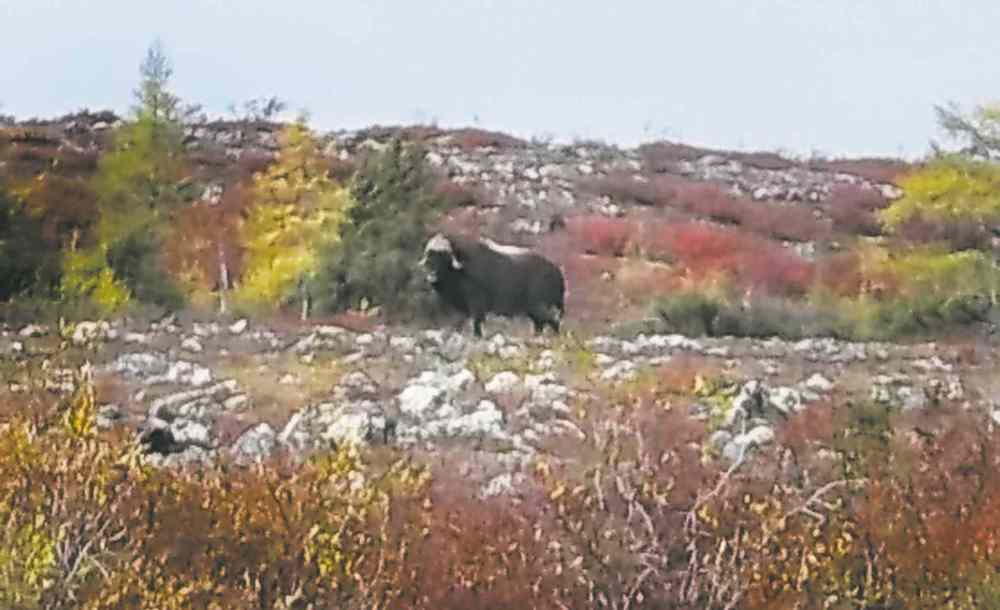Muskox makes rare appearance in Manitoba
None seen here since the 19th century
Advertisement
Read this article for free:
or
Already have an account? Log in here »
To continue reading, please subscribe:
Monthly Digital Subscription
$0 for the first 4 weeks*
- Enjoy unlimited reading on winnipegfreepress.com
- Read the E-Edition, our digital replica newspaper
- Access News Break, our award-winning app
- Play interactive puzzles
*No charge for 4 weeks then price increases to the regular rate of $19.00 plus GST every four weeks. Offer available to new and qualified returning subscribers only. Cancel any time.
Monthly Digital Subscription
$4.75/week*
- Enjoy unlimited reading on winnipegfreepress.com
- Read the E-Edition, our digital replica newspaper
- Access News Break, our award-winning app
- Play interactive puzzles
*Billed as $19 plus GST every four weeks. Cancel any time.
To continue reading, please subscribe:
Add Free Press access to your Brandon Sun subscription for only an additional
$1 for the first 4 weeks*
*Your next subscription payment will increase by $1.00 and you will be charged $16.99 plus GST for four weeks. After four weeks, your payment will increase to $23.99 plus GST every four weeks.
Read unlimited articles for free today:
or
Already have an account? Log in here »
Hey there, time traveller!
This article was published 17/09/2014 (4067 days ago), so information in it may no longer be current.
A muskox has been spotted in Manitoba for the first time since the 1800s, offering hope the large mammal will re-establish a breeding population inside the province.
On Sept. 11, five hunters from Tadoule Lake were looking for caribou along Nejanilini Lake, a large body of water 1,000 kilometres north of Winnipeg near the Nunavut border, when they saw a lone bull muskox near the shore of Weak Tea Bay.
“He was walking on the barren lands,” said Jo-Jo Thorassie, the first of five men in two boats to spy the animal. “We came near the shore, he came close to us. We didn’t even go on shore because he might have attacked us.”

While the muskox is not an endangered species on a national basis — there are more than 75,000 across Canada’s North — the mammal is officially listed as extirpated in Manitoba because no specimen has been sighted here since the 19th century.
Once common in northern Manitoba, muskoxen disappeared toward the end of the fur trade as their range contracted because of pressure from hunting and commercial harvesting.
“The belief is they were hunted out by residents of the fort up at Churchill, essentially through hunting parties, to provide food for people involved in the fur trade,” said Bill Watkins, a conservation biologist for Manitoba Conservation and Water Stewardship’s wildlife branch.
During the past two decades, Nunavut’s muskox population has been increasing and their range has been expanding, Watkins said.
During a survey in 1999, the mammals were spotted 250 kilometres from the Manitoba border, he said. In 2010, they were 100 kilometres away.
“We’ve been watching them move further and further south. I’ve been of the opinion this would finally happen one day, and it finally has. I’m quite excited about it,” Watkins said. “Hopefully, a female will follow.”
‘We came near the shore, he came close to us. We didn’t even go on shore because he might have attacked us’
— Jo-Jo Thorassie, the first of five hunters to spot the muskox
The lone bull muskox is what biologists call a vagrant. “It’s an animal that wandered in and will probably wander right out,” Watkins said.
The species will continue to be listed as extirpated in Manitoba until males and females are present and establish a breeding population within the province. At that point, the animal’s status will be upgraded to endangered within Manitoba, Watkins said.
Last year, trumpeter swans were upgraded to endangered from extirpated in Manitoba when their breeding range expanded north from Minnesota, Watkins said.
There are also hopes the barren-lands grizzly bear will re-establish itself in Manitoba’s north. In recent years, the large brown bears have been spotted every summer in northern Manitoba — but are not believed to be breeding in the province yet.
Watkins said conservation officials recently tranquilized and moved a lone male grizzly that was circling a hunting camp at Farnie Lake, immediately south of the Nunavut border.
The bear was released 60 kilometres southeast of the lake, he said.
‘I’ve been of the opinion this would finally happen one day and it finally has. I’m quite excited about it’
— Bill Watkins, conservation biologist
The vast majority of Canada’s muskoxen — 93 per cent of the population — resides on two islands in the High Arctic, Banks Island and Victoria Island, says the International Union for the Conservation of Nature.
The furry mammals, distant relatives of goats and sheep, eat sedges and grasses and are well-adapted to Arctic winters. They are famous for forming defensive rings around their calves when threatened by predators.
bartley.kives@freepress.mb.ca

